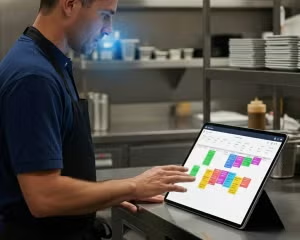Anyone who manages a budget knows cutting costs is always relevant. But it can be a frustrating exercise for the healthcare foodservice manager because many costs are out of your control. Examining practices that are within your control—tracking true plate cost instead of only the invoice cost—can help save money by recognizing purchasing, production and operational savings.
It’s valuable to look inward instead of outward. That’s because the price shown on the invoice is just the cost of the product, not a representation of everything that goes into each plate. There are labor costs, preparation costs, equipment costs, serving costs, waste costs, etc., that are all part of the bigger picture. No matter what the invoice says, it’s the final plate cost that matters. It’s a concrete, bottom line dollar amount you can break down as you look for savings.
There are several components to consider when optimizing your plate cost: maximizing your GPO contract, product rationalization, inventory management, menu utilization and labor and production efficiency.
Get the most for your money
One of the first steps in managing food costs is compliance with your food purchasing contract, says Dana Fillmore, RD, Gordon Food Service® Healthcare Segment Manager. Group purchasing organizations (GPOs) offer incentives—rebates and other rewards—for purchasing a certain percentage of contracted products.
“If there are two chicken products available and one is cheaper than the other, it’s tempting to order the cheaper product,” Fillmore acknowledges. “But if the cheaper chicken is not on your contract, purchasing it for a few pennies less could cost you a much larger rebate.”
What’s to gain by contract compliance? Strict compliance to the terms of your contract drives many other efficiencies—lower prices on the invoice, additional savings from rebates (such as drop size and brand), as well as operational savings that result from product standardization. Ultimately, the more you comply with your contract, the higher your savings. Often, products on a contract are selected for a reason, such as nutritional value. Alternate products may not measure up.
This requires communication between the healthcare kitchen manager and the administrator, says Sharon Carter, RD, Gordon Food Service Menu Specialist. The administrator needs to stress the importance of sticking to the contract. An unlocked order guide can be a tempting playground for a kitchen manager trying to do the right thing by saving a few dollars, Carter says.
“Most administrators don’t lock down the order guide because it’s a headache to unlock and relock each time a change is made,” Carter notes. “It’s valuable for the administrator, kitchen manager and even the foodservice distributor to discuss the importance of keeping within the contract.”
Rationalize and cross-utilize
Watching inventory can also be a money saver. When you buy the same product from two different brands, it adds to the paperwork and tracking, Fillmore points out. Two different cases, two different locations in your cooler … it costs time and money on the front end to keep track of what’s coming and going, and it’s expensive on the back end to manage production and reduce spoilage.
“If you want to make cheeseburgers, grilled cheese and tacos, you have three different needs for cheese and might buy three different products,” Fillmore says. “Can you buy just one cheese and use it three different ways? Thinking about cross-utilization when ordering can save money.”
Cross-utilization stretches products across different parts of the menu. The spinach purchased for a salad might also be used instead of spring mix as a bed for a salmon dish. Looking for these efficiencies is just one example of utilizing products in multiple ways. There’s also savings considerations in transforming recipes and recipe standardization.
“Sometimes a chef needs to know when to make changes,” Carter explains. “If the cost of strawberries and pecans goes through the roof, maybe I need to switch to Mandarin orange slices and walnuts for my spinach salad until the price comes down.”
The Gordon Food Service Cycle Menu Management system makes it easy to change recipes and adjust costs in real time, Carter says. Taking the plate cost of a salad from 75 cents a serving to 50 cents is just a couple of clicks away. Ingredient cost savings big and small can truly add up.
Taking a baked Italian chicken dish and turning it into a baked jerked chicken dish can offer plate cost savings. By simply taking the Italian seasoning out and substituting the jerk seasoning, which might be less costly, it creates a new dish at a lower cost.
In addition to monitoring the cost of each ingredient, Carter points to the importance of accurately scaling multiple-portion recipes.
“In healthcare, you know how many people you’ll be feeding most of the time, so why make 75 shrimp scampi dishes if you only need to feed 60 people?” she asks. “You might make a couple of extra servings in case one gets dropped, but you really reduce plate costs by scaling recipes to the right amount.”
Laboring to make a dent
Costing out ingredients and scaling recipes affects food cost, but that’s only part of the picture. The jerked chicken entrée doesn’t get served alone. There are sides, drinks and desserts and all of these only add up to the meal cost. There are also labor costs to each item that goes on a plate.
It may appear cheaper on the invoice to buy raw foods, but cooking from scratch requires prep time and labor expense, which must be factored into the plate cost. Speed scratch and ready-to-serve foods may carry a higher price, but they can save time and labor. It’s something to think about when looking for savings with always-available items, Carter points out.
“When you buy a cooked hamburger patty, all you do is heat and serve,” she says. “With uncooked patties, you have the labor costs of cooking and cleaning, plus a certain amount of fat and water content cooks out. Ready-to-serve may be cheaper than you think.”
Building a relationship
In addition to the rebates and savings when you reach contract compliance numbers, GPOs offer other benefits just for buying from them, Carter says:
- Consistent product portfolio with negotiated savings.
- Tools to help determine the most cost-effective and most efficient products for each job.
- Value-added services, such as interior design services.
- Services from manufacturers of larger equipment and furnishings.
An inventory solution
Managing your orders and labor is critical, but don’t overlook inventory cost-cutting efficiencies. The Gordon Food Service Inventory Manager tool can help:
- Customize storage to match your kitchen setup.
- Track all inventory instantly on your electronic device.
- Check long-term trends and operating performance.
- Monitor cost of goods sold to maintain your budget.












